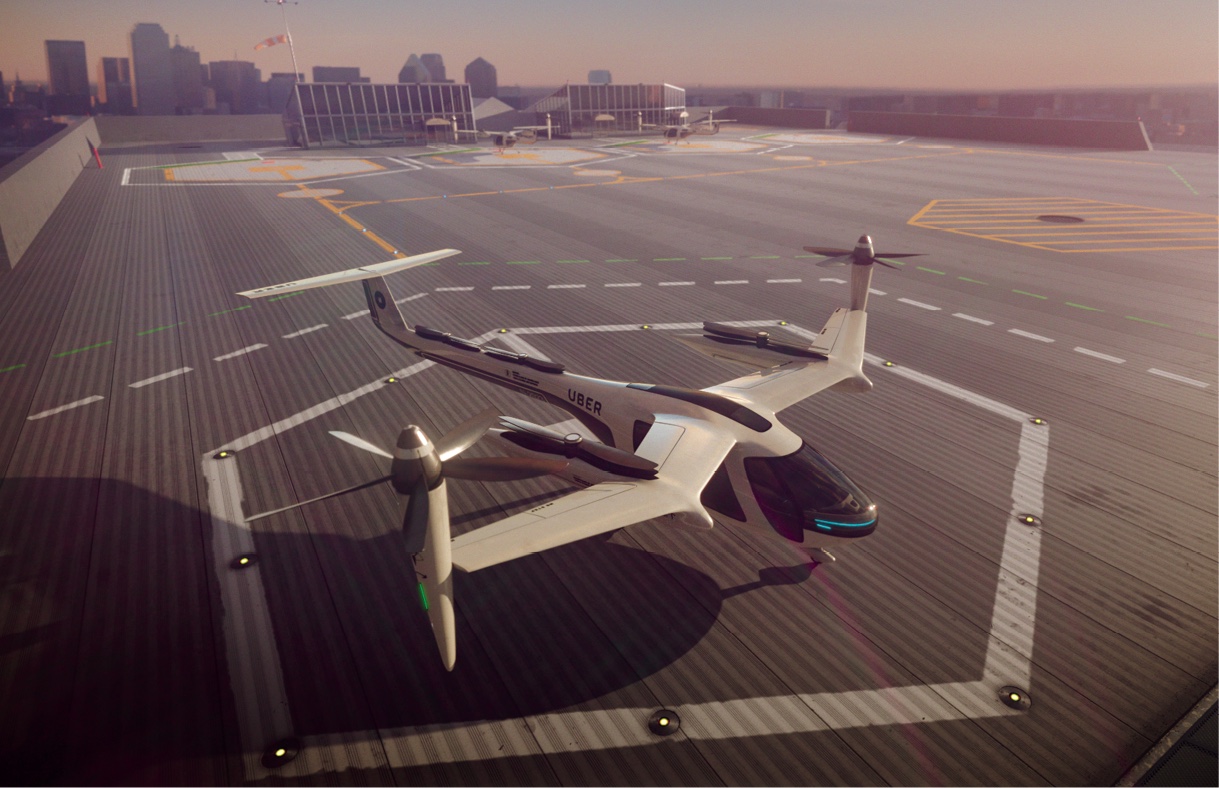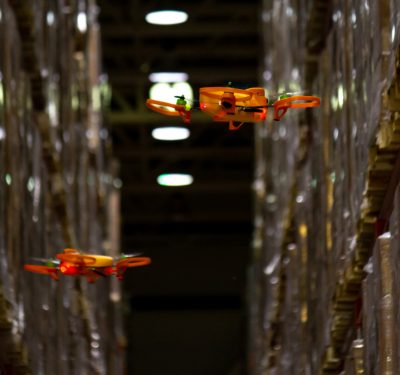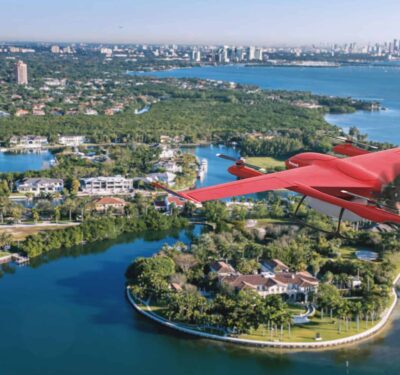
Photo courtesy of Uber Elevate
Those attending Austin’s SXSW 2018 had the opportunity to take in a variety of concerts, walk the large tradeshow floor and sit in on panel discussions—including a tech startup session where drone industry experts outlined how to make money in the unmanned aircraft systems (UAS) market.
“Taking Advantage of the Drone Evolution Revolution—How to Make Money in the Drone World Now, Soon and in the Future,” was moderated by Inside Unmanned Systems contributor Major General (ret) James Poss, who is the CEO of ISR Ideas. Panelists included Uber Elevate’s Director of Airspace Systems Tom Prevot, SkySpecs CEO Danny Ellis, and Duetto Group CEO Shawn Bullard.
During the session, panelists looked at various markets deploying consumer drones, beginning with those that can easily follow current Part 107 regulations and still realize the many benefits drones provide, and then moving on to industries that need more flexibility, such as the ability to fly beyond visual line of sight (BVLOS) or over people, before drones can offer real value.
Film, Press and Real Estate
When looking at which markets fit best within Part 107 rules, it basically comes down to applications that only require users to strap a camera to a drone to get the information they need—which is why movies, media and real estate were first on the list, Poss said.
There’s also typically no need to fly over people not involved in the operation or to fly BVLOS in these markets, Prevot said, making them perfect for current drone rules.
The movie industry was the first to adopt UAS whole heartedly, Poss said, and many of the beautiful aerial scenes you see today were captured via drone. UAS are also becoming more popular in the media, with CNN taking a huge step forward by receiving the first waivers to fly over people, which can be key when covering breaking news.
Ellis and Bullard both agreed these areas offer a lot of opportunity, but stressed it can be challenging for drone service providers to break in if they don’t have any industry experience.
“Successful people in any industry were already successful and then started flying drones to enhance their capabilities,” said Ellis, whose company focuses on wind turbine inspections. “Just because you get a drone and become a decent DJI Phantom pilot doesn’t mean you’re going to become a Hollywood producer tomorrow.”
Saving Lives
This category includes first responders, firefighters and hospitals that might be looking for ways to integrate drones into their operations. While Poss said this seems like a pretty good area that typically only requires cameras and flights within visual line of sight, there certainly are challenges that come with these life-saving applications.
For example, deploying drones to help fight large fires can become pretty complex, Prevot said, and BVLOS operations might be necessary at times. This application also requires a robust unmanned traffic management (UTM) system to distribute information and ensure everyone knows where drones are flying and which operations are priority. Research is being done by NASA and other parties to develop a UTM system that safely integrates drones into the national airspace no matter the mission, and while progress is being made, it could be awhile before a full UTM system is in place.
Bullard recently worked with a large health organization to implement drones into their operations, and said it isn’t as easy to accomplish as you might think. For example, right now medical helicopters can fly pretty much anywhere they want. Would drones carrying defibrillators or other life-saving cargo have the same access? Is the drone the give-way aircraft or does it take priority?
“These are the policy issues being discussed right now in the halls of Congress as well as with the FAA and NASA,” Bullard said.
Inspections
There are plenty of areas that can benefit from drone inspections, including infrastructure, oil and gas pipelines and power lines, Ellis said. These various assets either require routine inspections to meet safety requirements or as a way for owners to make sure they’re performing as efficiently as possible.
When Ellis first started looking at UAS inspection, he found people in these industries were grabbing drones off the shelf to take video, but then had no idea what to do with the data collected. While drones represented a safer way to preform inspections than traditional methods, users were crashing their systems and becoming frustrated with the process. They needed a good solution, and that’s where service providers like SkySpecs play a role.
Ellis and his team weren’t wind turbine experts when they started, but they hired people who were—which is something Ellis recommends for anyone looking to offer drone inspection services to a particular industry. It’s also important to remember one UAS doesn’t work for every job, and potential clients don’t care about the drone you’re using. They want to hear how the data you provide can improve efficiencies and save them money.
“The drone part does not matter,” he said. “All that matters is you are giving them data that helps them drive better business decisions. If you can drive better business decisions, people are going to care.”
Wind turbine and other assets can be inspected without flying BVLOS, but that’s not the case with every industry. For pipeline inspections to be effective, for example, pilots need the ability to safely fly BVLOS, Prevot said.
Mapping and Agriculture
In the early days of the commercial drone industry, precision agriculture was predicted to make up most of the UAS market, Poss said. In this market, there are no worries about privacy issues, flying over people or sharing the airspace with other aircraft. Drones also provide a better picture of crop health, and can tell farmers exactly where to spray pesticides.
The problem? It soon became clear farmers don’t want pictures, they want prescriptions, Poss said. Pinpointing exactly where pesticides need to go doesn’t save much money, and for UAS to truly benefit larger farms, they must have the ability to fly BVLOS.
Most farmers don’t need images instantaneously, Ellis said, meaning they get just as much benefit from satellite images as they do from drone images. There have been talks about using drones to actually spray pesticides, but adding weight to these systems comes with its own set of challenges.
Push back from the crop dusters association also created unexpected problems, Bullard said, as did the fact the optimum altitude for flying crops is between 900 and 1200 feet. UAS can’t legally fly above 400 feet without special permission from the FAA—and there aren’t a lot of famers who want to spend time applying for waivers (which we know are pretty difficult to get approved).
While flying larger drones (above 55 lbs) in controlled airspace and BVLOS could make this market more attractive, Prevot said the systems would have to meet additional requirements, making them a lot more expensive and difficult to employ.
It seems no matter the type of system used, precision agriculture just isn’t a scalable business model, Ellis said.
Package Delivery
While this is one of the most talked about areas in the drone industry, it’s also one of the most complex, Bullard said. Drones have to safely deliver packages directly to a person’s home, whether it’s coming from an Amazon warehouse or a UPS truck, which isn’t an easy task.
Ellis sees last mile delivery as a more feasible option than drones dropping off packages one at a time from Amazon, especially as delivery trucks become autonomous. Delivering single packages via drone will just be too expensive. Freighters will eventually handle deliveries autonomously, and one day packages will go from manufacturer to doorstep with no humans involved.
Many of what Bullard describes as “heavies” are working on drone delivery, including Amazon, UPS, FedEx and DHL.
“It’s got to fit into their regular business model,” Prevot said. “All of this will require a much more sophisticated traffic management system, especially if we do have multiple vehicles flying in airspace where we don’t currently have them.”
Urban Air Mobility
The panel ended with a discussion on Urban Air Mobility, or UAM. Through UAM, air taxis will transport passengers in congested cities, saving them time and money. This is the area Poss believes is the least likely to develop, but Prevot said there are many companies, including Uber Elevate, working to create electric VTOL aircraft and networks to make it a reality. To learn more about the work being done by Uber Elevate, NASA and other key players, turn to page 34.
As the drone industry continues to evolve, so will the regulations and the technology that make missions possible across many different verticals. There will be more opportunities to make money in this industry, whether it’s through applications that are already popular like inspection, or future applications such as air taxis.
“Pick something and be good at it,” Bullard said of how to capitalize in the drone market. “It’s OK to be scatter shot like a shot gun, but after you’ve done a couple scatter shots, pick out what you’re good at.”





